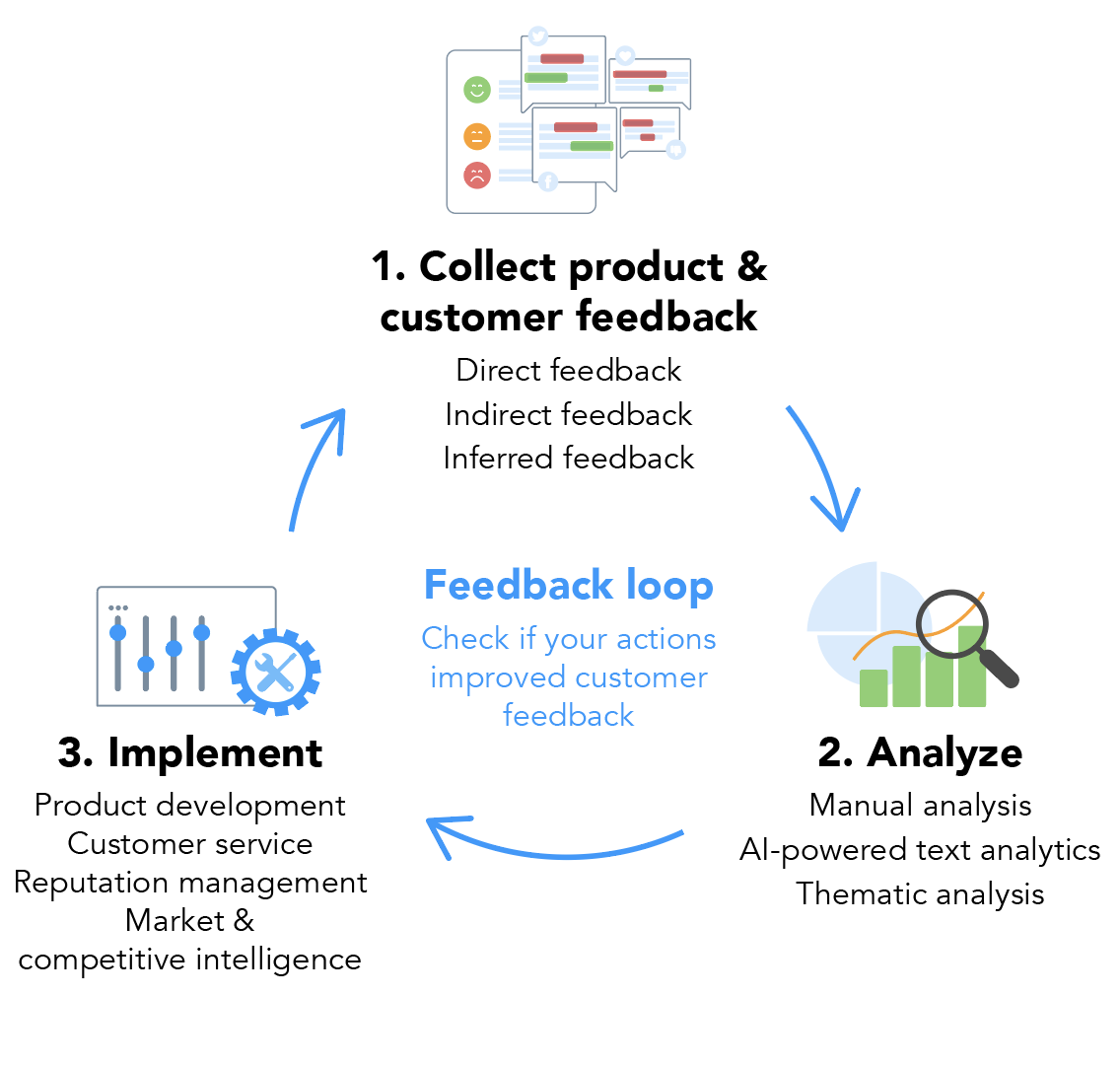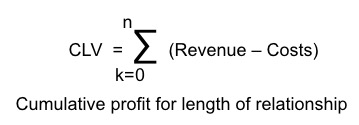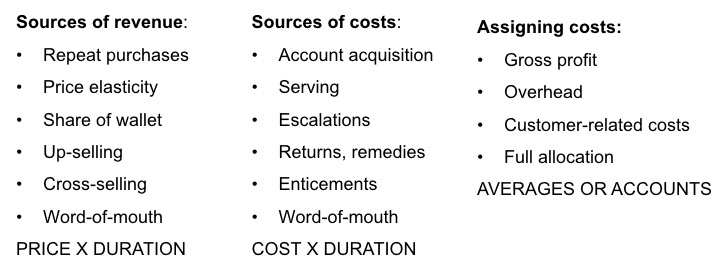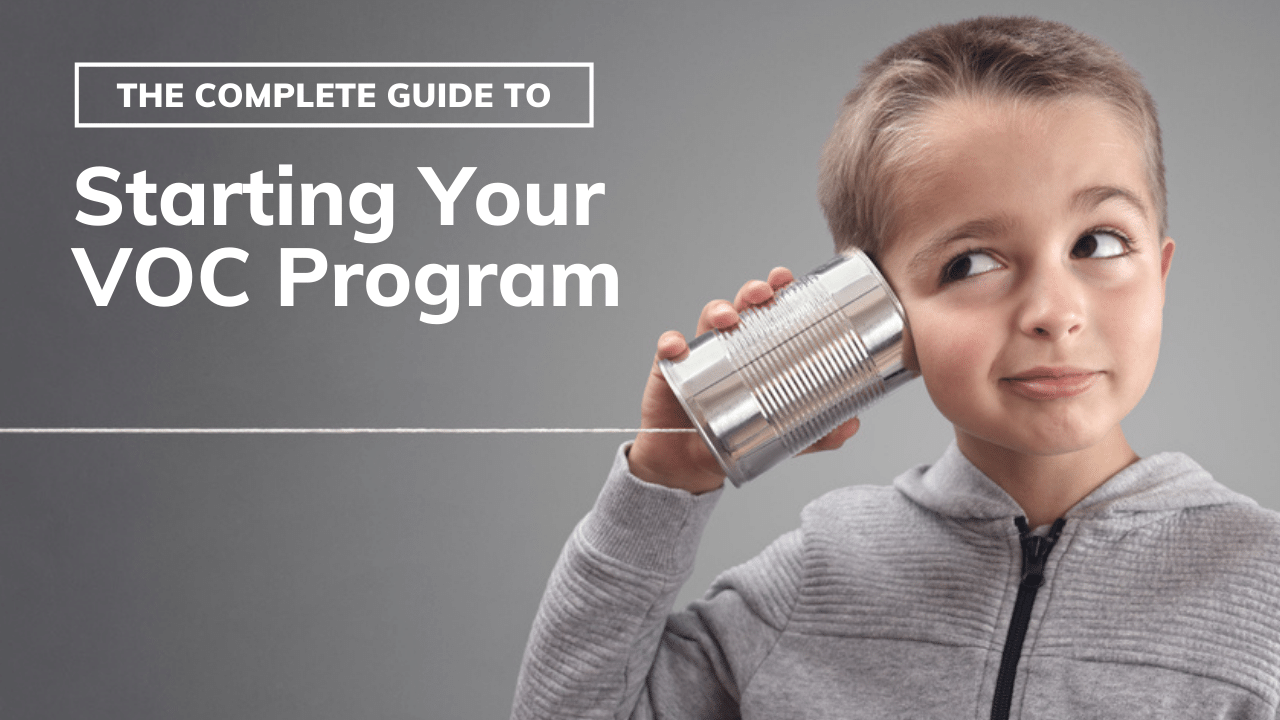Voice Of The Customer: Why you need it and how to start your VOC program
Why do some companies succeed with their VOC program while others struggle? We now have more data on customers than ever before, but discerning your customers' “voice” from all the noise can be really difficult if you don't have a proper system in place.
Organizations with a Voice of Customer program (VOC) have 55% greater customer retention rates and an average 23% decrease in year-over-year customer service costs! And, according to this report, best-in-class VOC users have a year-over-year increase in annual company revenue almost 10-times higher than other companies.
Although many companies have a VOC program, the leading VOC users are those that make the best use of the data they have. They know how to get the most value out of their VOC program.
In this guide, we’ll start by exploring what VOC is and why it matters. Then, we’ll dig into why it’s so important to understand your VOC feedback and how you can analyze this data to get useful insights. We’ll finish up by looking at how you can apply these insights to prioritize your roadmap and create products and services your customers truly want and need.
What is Voice of Customer (VOC)?
A Voice of the Customer program is the process of identifying, analyzing and acting on insights into your customers' preferences, expectations, and dislikes. VoC data focuses on customer and product experiences - with the goal of finding what’s most important and impactful to the customer.
MIT has a great overview which states VOC provides an “unparalleled insight into what your customers really want from your business and product”, as the feedback comes directly from your prospects. Once you understand what your customers want, you can tailor your product or customer experience to match their needs and desires.
Many organizations believe that by gathering feedback and executing surveys, they have a VOC program in place. In reality, a Voice of the Customer program is the entire process of collating customer feedback in one place and analyzing the data to see what customers care most about and why.
The final steps are ensuring the relevant people in your organization receive these insights and, crucially, can action them. A successful VOC program empowers everyone in the company, from product development teams to customer service agents, to make customer-centric decisions.
3 reasons your business needs to hear the Voice of Customer
VOC programs help you understand what your customers want and need from your products, services, or customer experience. Let’s look at the top three advantages of a VOC program for customer and product teams.
1. Better products and services
When done well, VOC programs help you build better products, with features that are a closer fit to customer requirements. They’re a great source of rich customer context that helps product teams to understand product issues and respond to customer needs. But how they analyze their data is what makes best-in-class VOC users so successful.
Simply looking at a bunch of feedback in separate silos will reveal a whole range of disparate issues which may or may not be important. But organizations who aggregate and thematically analyze their VOC data can easily see what matters most to their customers. In the words of these MIT professors, it provides a “common language for going forward in product development”.
2. Better customer experience
According to Gartner, “more than two-thirds of marketers say their companies compete mostly on the basis of customer experience (CX). And in two years’ time, 81% say they expect to be competing mostly or completely on the basis of CX. VOC programs help you to accurately capture and analyze customer experience at critical touch points in real time.
Common ways that VoC programs measure customer experience, like CSAT (customer satisfaction) and NPS (Net Promoter Scores), give your team a read on how customers experience your service or product. The best-in-class VoC teams then close the loop on drivers of customer satisfaction. Bigger enterprise customers will work with governance teams to drive change across the organisation. The teams respond with initiatives to address issues that have a high impact on the CX metrics, delivering a better customer experience and, by default, an improved score.
3. Grow top-line revenue
According to Gartner research, collecting feedback can increase upselling and cross-selling success rates by 15% to 20%. With a well-implemented VOC program, you also can better retain your customers. Think higher customer loyalty scores, less churn, and a greater customer lifetime value thanks to repeat purchases.
Customer feedback can help reduce the cost to retain buyers too. Companies that actively engage in VOC programs spend 25% less on customer retention than those that don’t.
How are companies using VOC?
As per the XM Institute’s State of VoC Programs report, most companies find their VOC programs to be the most valuable for “identifying and fixing quick-hit operational issues” and least valuable for “identifying innovative product and service ideas.”
This tells us that VOC is best at helping the company focus resources. It isn’t typically as useful for coming up with breakthrough innovation ideas. In this way, it helps products and experiences to be more successful for the company and more valuable to customers.
Subbly: VOC for SaaS Products
The SaaS startup Subbly takes VOC seriously. They have a dedicated feedback page, run surveys on their pricing page and regularly use their Facebook group to ask their audience what they think of their product.
“Between all these methods of collecting the voice of the customer,” explained Stefan Pretty, Founder and CEO of Subbly, “we harness their [opinions] on the best way to run Subbly, to shape our product roadmap and the features we roll out. It seems to work well. We’re extremely customer-centric, and because we’re bootstrapped, it has to be that way.”
Subbly also uses these insights to inform new features. For example, their tax calculation feature and a revamped checkout process were inspired by customer survey results.
Implementing a VOC program
So, how can your company replicate Subbly’s success and incorporate your VOC data into your CX and product development processes? In this section we’ll share the 4 simple steps you need to follow to build your VOC program.
- Collect customer feedback or product feedback – Use methods like customer surveys to gather information from your customers.
- Analyze – Analyze responses to uncover key trends, themes and customer expectations.
- Implement – Act on these insights to improve the areas of the business that will drive the biggest change. For example, customers may express a desire for longer battery life for a particular laptop. Product development teams can action these types of comments by including this feature in the design of a new or improved version of the laptop.
- Loop back to customer feedback – Gather new customer feedback and check how your actions have improved customer and product experience.

Step 1. Collection of product and customer feedback
Collection of high-quality feedback is crucial if you want to really listen to what your customers are saying and act on this Voice of the Customer data. Make sure you avoid the most common mistakes when collecting feedback.
Tip: Make sure you get focused and useful improvement suggestions by asking customers for feedback in an easy and convenient way. For example, try asking open-ended questions like “What are some of the things we can improve about this product?”
If you don’t have access or the means to conduct a survey, don’t despair. You probably already have access to lots of feedback without realizing it!
In addition to customer and product surveys, you can analyze unstructured feedback from support tickets, chat logs, forums, social media comments, call centre notes, chatbots interactions and online customer reviews, etc. Unstructured data is typically textual, like open-ended survey responses and social media conversations, but can also be non-textual, like images, video, and audio. Almost any type of unstructured data will contain interesting product or customer service insights
There are 3 categories of feedback data you can use:
- Direct feedback: Feedback given directly to the company when the customer knows that the organization is listening and is expecting a response. This can be via surveys, complaints forms, market research or focus groups.
- Indirect feedback: When customers talk about your company and products, but not necessarily to it. It might be social media messages, online reviews or text analytics used for customer care interactions.
- Inferred feedback: Operational, behavioral and transactional data that is associated with a customer experience, which can include website data, purchase history or contact center data. This can also be useful for understanding what customers think of your products.
Companies should aim to gather feedback data on a regular basis to maintain momentum and track insights over time.
Step 2. Analysis
Let’s look specifically at the analysis of unstructured data in the form of product and customer feedback responses, since that is where the richest insights often lie. You can use this kind of text or feedback data to understand what matters to customers and why.
Manually analyze feedback
Companies can manually analyze text feedback, with a data analyst or team applying certain rules, taxonomies and categorization to the data. Although these different manual analytics approaches have advantages, VOC programs with manual approaches are often plagued with human bias and take a long time to implement.
Easier to analyze data with AI
It’s now a great deal easier (and faster) to be able to understand your customers, with feedback analytics solutions powered by text analytics and artificial intelligence (AI). By using AI, you can automatically analyze hundreds and thousands of text feedback comments. A good software solution will quickly organize and quantify the various themes (or categories of ideas) and sentiments that have arisen across the feedback. In this way you can get a quick and unbiased view of your VOC without the time and effort of manual analysis.
To capitalize on these advances in AI powered text analytics, companies can build a solution or buy a software solution designed specifically to find insights in unstructured data.
Bonus: For a run-down of different types of text analysis approaches, we have put together this comprehensive review of text analytics approaches (including a handy cheat sheet of pros and cons).
Use Thematic feedback analytics software to find insights
Feedback analytics software, designed to analyze unstructured and structured customer feedback, is a great tool for your VOC program. Here’s how software like Thematic can help you uncover and act on crucial insights in your customer or product feedback:
Automatically interpret and code patterns in feedback
Thematic automatically organizes feedback data into groups, so you can see what’s most common, what’s most important and why. Based on similarities, themes emerge from the comments and data. Some common themes are customer pain points, goals or needs. So, for instance, you’ll discover feedback about specific functionality issues (e.g. search or a new update) or credibility-related insights. It’s much faster, easier and more organized to use AI powered software like Thematic than manual approaches.
Break down data silos
Thematic makes it really easy for teams to compare feedback across sources by organizing and analyzing all feedback text in the same way. The software generates a two-tiered theme taxonomy (codes) for every data set, automatically tagging feedback with themes and sub-themes. Analysts can jump straight to the most important themes or topics that customers are talking about, whatever the source, to explore the context and get verbatims.
View all your VOC insights in one place
Thematic enables companies to analyze all their customer feedback in one platform, making it easier to see what's most important to customers and why. Putting all the data in one place ensures insights are available to all teams. This helps the whole company to access and respond to these valuable insights.
Straightforward feedback reporting
Companies can also use Thematic’s software to find recurrent and emerging feedback themes, track trends and issues, and create visual reports for managers to track whether they are closing the feedback loop with the end customer.
What are actionable insights?
Many companies are great at data collection. But they often struggle to derive actionable, meaningful insights from this feedback.
To make sense of your customer and product data, getting actionable insights is essential. So, what’s the difference between insightful and non-insightful data?
- Non-insightful data is something that you already knew was a problem.
- Insightful is everything that you didn’t know. Insights are findings that contradict your knowledge, confirm your suspicions or quantify the importance. They help give a more complete picture of what your customers are experiencing.
Actionable insights lead to either change and an action or confirm the fact that you don’t need to take any action at all.
So, how actionable are your insights?
Try to find examples of actionable insights in your business. Here we’ve come up with a few examples. Which out of these would you say are actionable insights?
- Passengers complain about missed flight connections
- 20% of customers talk about price
- Buyers say that clothes sold by a competitor are better quality
- People talk about our brand more positively following a product redesign to use only recycled plastics for plastic bags
- Twice as many Detractors talk about Product’s ease of use
Answer: the first 3 bullet points are not actionable for the business, and not very insightful.
Step 3. Implementation
Now you’ve collected lots of feedback and analyzed it, what do you do with it and how do you drive change?
Often, organizations don’t know what the right change is and how they can drive continuous improvement. If this is you, the 3 things you need to know are:
- Just conducting surveys isn’t enough anymore
- Insights in a vacuum don’t work. Insights need to be shared and democratized, and reported upon across your organization in a relevant and accessible way.
- To drive change you have to get strategic in how you look at insights and action them appropriately.
How to use VOC data to inform change
Here are some examples of how you can use your insights to drive change within a business:
- Customer experience: Understand how satisfied your consumers are at different touchpoints, and their willingness to recommend your brand to others.
- Product development: Get feedback on new product ideas; understand price sensitivity, or determine when to retire products.
- Reputation management: Monitor your brand’s reputation in the marketplace.
- Market and competitive intelligence: Understand consumer buying patterns and preferences, capture trends, social and environmental impacts on buying behaviors, and discover what customers say about competitors.
How to make it work - 4 best practices for a successful VOC program
These are our top tips for VOC improvements you can do across the board in order to turn insights into action.
1. Strategy comes first
Make sure you have the basics right from the start. It's a recipe for failure if you don't set up a clear governance structure with a mission, leadership and an execution strategy for acting on the customer feedback you’ll uncover.
The first step is to set a solid VOC strategy that has buy-in from the CEO and board. Then, you create a VOC program that is owned by someone who has sole responsibility for making VOC happen. This individual should be in sync with the corporate leadership so the CX strategy aligns with the wider business strategy.
Correlate the VOC questions to relevant and attainable goals and remember to adhere to good survey hygiene. Finally, act on these new insights and review the impact of these changes as they are implemented to measure the success of your VOC program.
2. Get the right insights into the hands of the right people
Getting insights to the right people who can drive change is not about just sharing VOC data in a quarterly board presentation in a PowerPoint deck.
To drive real growth and change in organizations you need to get the insights that matter to the right teams and individuals quickly and easily. You’ll also need to monitor and assess the initiatives they create with these insights.
And you can only do that with technology solutions that integrate with your current workflows. The best approach is to find a strong feedback analytics solution with reporting solutions that are useful and accessible to key decision makers.
With Thematic, you can set up automatic alerts into Slack or email for emerging feedback or significant changes. Users can easily build editable dashboards to display the results and provide access to anyone who needs deeper analysis. Analyzed data is also easily exported to other tools in your technology stack, like PowerBI or Tableau.
3. Formalise VOC efforts
You need to formalise your improvement efforts internally with some kind of governance structure. Companies need a systematic approach to understand and learn from VOC feedback, along with a mission and leadership that supports VOC action.
That will help you incorporate insights into strategic business decisions, and then develop initiatives to improve CX. Often, the actual structure of your business model needs to change, as well as the wider business philosophy.
4. Honestly assess your company culture
Company culture is one of the hardest things to change, but it can have a big impact on everything from product development procedures to customer service response times. That’s why it’s so important to do an honest assessment of your company’s culture. Are you really putting your customers first in every instance?
If you’re not focused on optimizing the customer experience, you’ll be unable to deliver anything more than just average service. By changing their company culture, companies can empower their employees to make a truly memorable impact for customers and the organization.
Are companies acting on their VOC insights?
According to organizations who use VOC, 60% rate their efforts at soliciting customer feedback as ‘good’, as per a survey of 169 large companies made by the Temkin Group, The State of VOC Programs report.
However, the same research found that only 24% of companies think they are good at making changes to the business based on VOC feedback. And, they also found that only 40% of enterprises think they are good at sharing feedback across the organization.
These are the two most important factors when it comes to the effectiveness of VOC. Only 14% of companies have reached the two highest levels of VOC maturity (out of six levels), while 46% remain in the bottom two levels.
So companies clearly realize the need for VOC, but they often fail to act on that data.
VOC programs that fail to deliver change waste valuable time and resources. In addition, when companies fail to act on customer feedback, customers may feel that they’re being ignored. This can do lasting damage to your customer relationships. They may be hesitant to share useful feedback in the future. What’s more, your brand reputation could also suffer as a result.
VOC Case Study: Atom Bank transforms banking experience
Atom Bank worked with Thematic to transform their banking experience based on what mattered most to their customers. Atom Bank is a relatively young bank that wants to disrupt the industry. From the very beginning they took customer feedback seriously. Every change they've made has been built on one core belief: “Everything we do should make customers’ lives easier”.
Atom Bank has used a variety of feedback channels from their earliest days, including running surveys and focus groups and engaging in online communities. Their aim was to identify any underserved customer needs that could help them develop and improve their services.
All of this data was held in spreadsheets and required a lot of manual work to analyze and make sense of. Atom Bank wanted a way to streamline and speed up the data processing using a simple digital solution that could work alongside their human expertise.
Using Thematic’s feedback analytics software, the Atom Bank team were able to identify individual “themes” or topics that were impacting customer satisfaction. For example, “authentication” was highlighted as an important theme. The team could then dig deeper into this theme to understand what exactly was causing this friction.

Further analysis showed that “biometrics” was an area that needed greater attention. This sub-theme had a -6.3% impact on the Customer Goodwill Score, the overall metric used to track customer satisfaction. Looking at the other sub-themes here reveals further information. “Biometric not working” and “face recognition not working” are two more specific issues mentioned in customer feedback.
With all these credible customer insights, the Atom Bank team could prioritise the app features they knew would have the most impact. This enabled them to transform their banking experience based on what mattered most to their customers. And as a result, they are now the most trusted bank according to Trustpilot with a score of 4.6/5!
How to get buy-in for your VOC insights
This section is courtesy of our webinar with Lynn Hunsaker.
Getting buy-in from the stakeholders in your company is often the most important component of a VOC program. What’s the point of having the best plan in the world if no one is going to assign budget for the project? If the CEO does not buy into it, VOC is never going to be at the top of anyone’s priority list.
Top tips for getting buy-in
When you create your pitch or board presentation, it’s pretty standard to focus your VOC goals on sources of revenue. These could be repeat purchases, upsell and cross-sell and customer lifetime value. But to really create a sense of urgency, look at what unexpected costs your customers can incur and explain why this is important.
- Look at how much it costs to acquire customers. Costs to consider are sales collateral, conversations and the efforts around getting customers onboard.
- Point out what it costs to serve your customers, including the daily management of their orders and delivery as well as tech support and customer support.
- Next, consider the returns and actions needed for those particular situations. Don’t forget about enticements such as a loyalty program or volume discounts and warranty extensions launched to maintain certain customers or to attract others, or to make up for any operational discrepancies.
- Finally, there’s the cost of negative word-of-mouth. Unhappy customers might share negative feedback with their contacts that can cost you revenue.


It’s good to quantify anything in your VOC insights that might impact these costs as risk elements. They’re yet another reason for stakeholders to take action using your VOC insights.
If you’re working on getting buy in for your VOC program, you’re probably looking at pulling together a large range of costs and returns. It’s easy to get overwhelmed. The best thing you can do to help yourself is to be organized, intentional and structured. A tool like our ROI of CX guide can help you organize and manage your costs and revenue, and make calculations based on your own VOC program
Final thoughts
We hope that this article has shown you how important VOC is and how you can apply it to your business. Let’s close with a few thoughts on how you can optimize your VOC and make sure you’re getting the results you need.
A common issue for companies initiating a VOC program is they don’t circle back and connect their findings to changes in customer behavior. It’s crucial to link customer perceptions and behaviors with the actual feedback collated. Another key element of any VOC program is documenting your findings so you can show all relevant stakeholders how it’s delivering ROI for your business.
Succeeding at VOC programs comes from acting on the feedback that really matters. The sad truth is that some product development and CX efforts will just be a waste of money, because feedback isn’t prioritized. Prevent this by drilling down into what really matters to your business, and prioritize making the changes your customers identify as the most important.
A solution like Thematic can help you get more value from your customer feedback, prioritize impactful pain points, understand why they matter and transform the product and customer experience.
You can learn more and sign up for access at Getthematic.com




